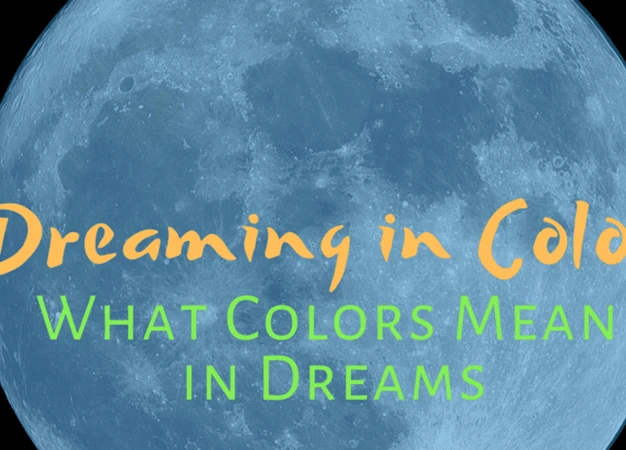Dreams are enigmatic and mysterious, often leaving us puzzled about their meaning and significance. One intriguing aspect of dreams is the presence of colors, which can hold powerful symbolism and evoke profound emotions. The colors we encounter in our dreams can provide valuable insights into our subconscious thoughts, desires, and fears. From the fiery passion of red to the serene tranquility of blue, each color holds its own significance, offering a unique lens through which to understand our dreams. In this article, we will delve into the symbolism of colors in dreams, exploring common interpretations, personal associations, cultural influences, and the role of color combinations and intensity. By understanding the deeper meanings behind these vibrant hues, we can unlock the hidden messages that our dreams are trying to convey.
Contents
- The Importance of Colors in Dreams
- Common Interpretations of Color Symbolism
- Personal Associations and Cultural Influences
- Understanding Color Combinations
- Interpreting the Intensity of Colors
- Exploring Context and Situations
- Conclusion
-
Frequently Asked Questions
- 1. What does it mean if I dream in black and white?
- 2. Why do certain colors repeat in my dreams?
- 3. Can the interpretation of color symbolism in dreams vary across cultures?
- 4. What does it mean if my dreams are filled with vibrant and intense colors?
- 5. Are there any universal color symbols in dreams?
- 6. Can the same color have different interpretations in different dreams?
- 7. Can the color symbolism in dreams change over time?
- 8. Are there any resources for further exploring color symbolism in dreams?
- 9. Can the intensity of a color in a dream affect its interpretation?
- 10. How can I use the symbolism of colors in dreams to gain self-awareness?
- References
The Importance of Colors in Dreams
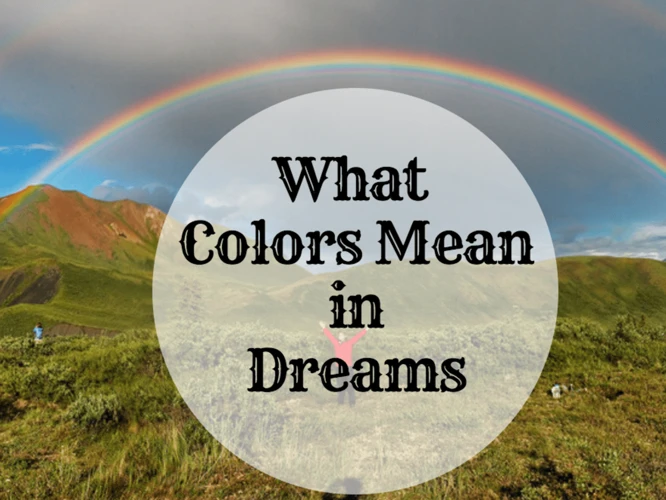
In understanding the importance of colors in dreams, it is essential to recognize that colors hold significant meaning and can convey a wide range of emotions and symbolism. Colors have the power to evoke various feelings and associations, even within the dream state. Each color has its own unique symbolism and can provide valuable insights into the subconscious mind. For example, the color red often represents passion, energy, and strong emotions. It may signify intense desires, anger, or even warnings. On the other hand, blue is often associated with calmness, tranquility, and serenity. It can represent a sense of peace or emotional stability. Yellow, with its vibrant and sunny nature, typically symbolizes positive energy, joy, and optimism. Green, the color of nature, frequently represents growth, healing, and renewal. Purple, being a combination of red and blue, can represent a blending of passionate and calm energies. It can symbolize spirituality, intuition, and creativity. Orange is often associated with enthusiasm, vitality, and creativity. White, a symbol of purity and innocence, may represent a fresh start or a clean slate. Black, with its dark and mysterious nature, can signify the unknown, hidden fears, or even transformation. Brown is often related to stability, reliability, and groundedness. Lastly, gray, the color between black and white, may represent ambiguity, neutrality, or uncertainty.
Understanding the symbolism of colors in dreams can help unravel the hidden meaning behind our subconscious thoughts and emotions. Each color carries its own significance, and when interpreted in the context of a dream, it can provide valuable insights into our innermost fears, desires, and aspirations. By paying attention to the colors that appear in our dreams, we can gain a deeper understanding of ourselves and the messages our subconscious is trying to convey. Whether it’s flying through the sky (/symbolism-flying-dreams/), swimming in deep waters (/symbolism-of-water-dreams/), or even encountering death (/decoding-symbolism-death-dreams/), exploring the importance of colors in dreams invites us to delve into the depths of our psyche and unravel the mysteries that lie within.
Common Interpretations of Color Symbolism
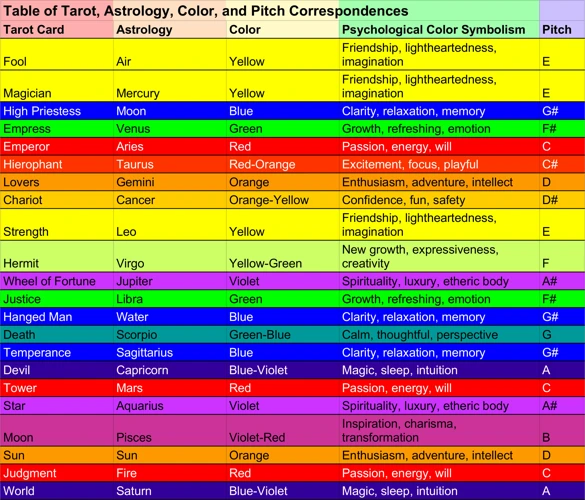
Colors hold deep symbolic meanings, and understanding these interpretations can offer valuable insights into the symbolism of color in dreams. Here are some common interpretations of color symbolism to consider. Red, with its vibrant and intense nature, often represents passion, love, and strong emotions. It can also symbolize anger, danger, or warning signs. Blue, on the other hand, is associated with calmness, serenity, and tranquility. It represents emotional stability and can signify a sense of peace. Yellow, with its bright and sunny shade, is commonly linked to joy, happiness, and positivity. It embodies optimism and can uplift the spirit. Green, as the color of nature, symbolizes growth, renewal, and vitality. It is connected to healing, abundance, and harmony. Purple, a blend of red and blue, represents a fusion of passion and calmness. It often signifies spirituality, intuition, creativity, and luxury. Orange, with its vibrant and energetic hue, symbolizes enthusiasm, vitality, and creativity. It represents excitement and optimism. White is associated with purity, innocence, and purity. It signifies a fresh start, new beginnings, and a clean slate. Black, with its mysterious and dark nature, often represents the unknown, hidden fears, and profound transformation. Brown symbolizes stability, reliability, and being grounded. Lastly, gray, as the color between black and white, represents ambiguity, neutrality, and uncertainty. Understanding these common interpretations of color symbolism can help decipher the meaning behind the colors that appear in our dreams, providing deeper insights into our subconscious thoughts and emotions.
1. Red
Red is a color that exudes passion, energy, and intensity. When red appears in dreams, it often carries significant symbolism. It can represent powerful emotions, such as love, anger, or desire. Red can be an indication of strong physical or emotional energies that are present in your waking life. In dreams, it can also serve as a warning sign or alert you to potential danger. For example, seeing red in a dream might indicate the need to pay attention to certain aspects of your life that require immediate action or caution.
Red can symbolize power, bravery, and assertiveness. It represents the life force and vitality within us. In dreams, the color red may be associated with moments of empowerment or the need to stand up for oneself. It can be a reminder to tap into your inner strength and take charge of your circumstances.
On the other hand, red can also have negative connotations. It can be associated with anger, aggression, or feelings of being overwhelmed. If you dream of a deep red color, it might reflect repressed emotions or unresolved conflicts that need to be addressed. The intensity of red in dreams can indicate the level of emotional charge or turmoil within a particular situation or relationship.
It’s important to consider the context and personal associations when interpreting the symbolism of red in dreams. While it generally signifies passion and energy, the specific meaning can vary depending on individual experiences and cultural influences. Some people may associate red with love and romance, while others may see it as a symbol of danger or warning.
Red in dreams symbolizes passion, energy, power, and intensity. It can represent strong emotions, the need for action or caution, as well as moments of empowerment or assertiveness. However, it’s crucial to consider the context and personal associations to fully understand the meaning of red in a dream.
2. Blue
Blue, the color associated with the vastness of the sky and the soothing calmness of the ocean, holds significant symbolism in dreams. When blue appears in dreams, it often represents tranquility, peace, and emotional stability. It can suggest a need for relaxation and a desire for serenity in waking life. The shade of blue encountered in the dream can also offer additional insights. For instance, a bright and clear blue might signify clarity of thought and a sense of purpose, while a darker shade of blue could represent feelings of sadness, melancholy, or depth of emotions. Dreams featuring a blue color palette may indicate a need for emotional healing, a desire for communication and expression, or a longing for spiritual connection and introspection. Blue can also be associated with qualities such as trust, loyalty, and sincerity. In the dream context, this may suggest the need for open and honest communication with others or the importance of building trustworthy relationships. The color blue in dreams carries a sense of tranquility, emotional balance, and the potential for self-reflection and growth.
3. Yellow
Yellow is a vibrant and uplifting color that often symbolizes brightness, joy, and optimism. When it appears in dreams, it can carry significant meaning. Dreams with yellow hues may represent a period of happiness, success, or newfound energy in an individual’s life. Yellow can also represent a sense of clarity and enlightenment. It may signify a time of personal growth, self-discovery, or awakening. Additionally, yellow can symbolize intelligence, creativity, and curiosity. Dreaming of yellow objects or surroundings could indicate a need for mental stimulation or a desire to explore new ideas and experiences. On the other hand, yellow can also have negative connotations in dreams. It may indicate caution or a warning to be aware of potential risks or deceit. The specific context of the dream, as well as the emotions and associations evoked by the color yellow, should be taken into account when interpreting its symbolism. Yellow in dreams is often a positive symbol, representing optimism, happiness, and a zest for life.
4. Green
Green is a color often associated with nature, growth, and harmony. In the context of dreams, the color green can carry a variety of symbolic meanings. One interpretation of green in dreams is that it represents personal growth and transformation. It may indicate that the dreamer is going through a period of personal development or experiencing positive changes in their life. Green can also signify balance and harmony, suggesting that the dreamer is in a state of emotional or spiritual equilibrium. It is a color that often brings a sense of calmness and tranquility.
In some cases, green in dreams may be associated with environmental awareness and the need for connection with nature. It can serve as a reminder for the dreamer to prioritize their relationship with the natural world and seek a deeper connection with the environment. Alternatively, green may symbolize fertility and abundance. Dreaming of green landscapes, plants, or gardens may indicate a period of growth, prosperity, and new opportunities.
On the other hand, green can also have negative connotations in dreams. It might represent jealousy or envy, suggesting that the dreamer is experiencing feelings of resentment or insecurity in their waking life. Additionally, green can symbolize a sense of stagnation or being stuck in a rut. Dreaming of a dull or muted shade of green may indicate that the dreamer is feeling uninspired or lacking motivation.
As with all dream symbols, the interpretation of green can vary depending on the personal experiences and associations of the dreamer. It is important to consider the specific context of the dream and the emotions evoked by the color green. By reflecting on these elements, the dreamer can gain a deeper understanding of the message or lesson their dreams are trying to communicate.
5. Purple
Purple is a captivating color that holds a unique symbolism in dreams. As a combination of red and blue, purple represents a harmonious blend of passionate and calm energies. In the realm of dreams, the color purple often signifies spirituality, intuition, and creativity. When purple appears in a dream, it can indicate a deep connection to one’s higher self or the spiritual realm. It may suggest that the dreamer is in tune with their inner wisdom and intuition, urging them to trust their instincts and make decisions that align with their spiritual path. Purple in dreams can also symbolize the exploration of one’s creative potential. It may signify a time of inspiration, artistic expression, or the need to tap into one’s imaginative abilities. Additionally, the presence of purple in dreams can evoke a sense of mystery and enchantment. It may indicate that the dreamer is entering a period of transformation or embarking on a journey of self-discovery. However, it is important to consider the context and other elements of the dream to fully interpret the meaning of purple. For example, a dark shade of purple might suggest hidden desires or unresolved emotions, while a light shade could represent positivity and spiritual growth. The appearance of purple in dreams invites the dreamer to embrace their spiritual side, embrace their creativity, and embark on a journey of self-exploration and transformation.
6. Orange
Orange, as a vibrant and energetic color, holds significant symbolism in dreams. When the color orange appears in dreams, it often signifies enthusiasm, vitality, and creative energy. It is a color that represents warmth and positivity, evoking feelings of excitement and inspiration. Dreaming of the color orange can suggest that you are experiencing a surge of creativity or enthusiasm in your waking life. It may indicate that you are feeling motivated to pursue new projects or take on challenges with a renewed sense of energy.
In addition to representing creativity and vitality, dreaming of orange can also symbolize social interaction and connection. It may suggest that you are seeking companionship or desiring to engage in social activities. Orange is a color that encourages communication and socialization, so seeing it in a dream could be a sign that you are craving connection with others or that you are in a social phase of your life.
Orange in dreams can also represent passion and sensuality. It may indicate that you are experiencing strong emotions or desires in your waking life, particularly in matters of love and relationships. This color can symbolize the fire within, drawing attention to your passionate nature or the intensity of your emotions.
It is important to consider the context and other elements of the dream when interpreting the symbolism of orange. The specific situations and emotions associated with the color can provide deeper insights into its meaning. For example, if you dream of an orange sunset, it can represent a time of transition or a beautiful change on the horizon. On the other hand, if you dream of an orange fruit, it could symbolize abundance, fertility, or nourishment.
Ultimately, the interpretation of the color orange in dreams depends on the individual’s personal associations and cultural influences. While orange generally represents enthusiasm, creativity, social interaction, and passion, it is essential to consider how these meanings resonate with your own experiences and emotions. Exploring the symbolism of orange within the context of your dream can provide valuable insights into your subconscious feelings, desires, and motivations.
7. White
White, in the realm of dream symbolism, carries a powerful and distinct meaning. It is often associated with purity, innocence, and new beginnings. When the color white appears in a dream, it can represent a fresh start or a clean slate. It signifies a sense of clarity, purity of thought, and a state of calmness. White can also symbolize spiritual growth, enlightenment, and transcendence. Dreams featuring white can be a representation of the desire for a pure and untarnished life or a longing for inner peace and harmony. This color is commonly associated with weddings and celebrations, suggesting a time of joy and happiness. Additionally, white can serve as a symbol of protection and guidance, offering a sense of comfort and reassurance during challenging times. It represents a lightness and simplicity that can bring solace to the dreamer. In the context of dreams, white can also have connections to the concept of surrender, urging the dreamer to let go of control and allow life to unfold naturally. It invites an open and receptive mindset, encouraging the dreamer to embrace the purity and possibilities that lie ahead.
8. Black
Black in dreams is a color that often carries deep and mysterious symbolism. Associated with the unknown and the subconscious mind, black serves as a symbol of hidden fears, secrets, and transformation. When black appears in a dream, it may signify a sense of mystery or uncertainty. It can symbolize the need to confront and explore fears or unresolved issues in one’s life. Black can also represent the unconscious mind, urging the dreamer to delve into their deepest thoughts and emotions.
In some cases, black may represent a need for change and transformation. Just as darkness gives birth to light, black can symbolize the potential for growth and renewal. It may be an invitation for the dreamer to embrace the unknown and embark on a journey of self-discovery and personal transformation.
However, it is important to note that the interpretation of black in dreams can vary depending on the context and personal associations of the dreamer. For some individuals, black may evoke negative connotations and represent fear or negativity. For others, it may symbolize elegance, power, or formality.
To fully understand the meaning of black in a dream, it is crucial to consider the emotions and situations surrounding its appearance. Are you feeling overwhelmed by darkness and uncertainty? Or do you feel empowered and ready for a positive change? By exploring the details and emotions of the dream, one can gain deeper insights into the personal significance of black and its role in their subconscious mind.
9. Brown
Brown is a color that often symbolizes stability, reliability, and groundedness. In the context of dreams, the appearance of brown can represent a need for security and a desire for a stable foundation. Brown is often associated with the earth and nature, evoking a sense of warmth and comfort. It can symbolize a need to reconnect with the natural world and find balance in life. Brown can also represent practicality and a down-to-earth attitude. When brown appears in a dream, it may signify that it is time to focus on taking care of practical matters and attending to responsibilities. It can serve as a reminder to stay grounded and approach situations with a practical mindset. Additionally, brown can have associations with reliability and dependability. It may suggest the need to rely on oneself or others who are trustworthy and dependable. In some instances, brown may also be related to the idea of simplicity and a desire to simplify one’s life by eliminating unnecessary complexities. The appearance of brown in dreams can signify the need to find stability, rely on practicality, and reconnect with the natural world for a more grounded and balanced existence.
10. Gray
Gray, often regarded as a neutral color, possesses its own unique symbolism in dreams. When gray appears in a dream, it typically signifies ambiguity, neutrality, or uncertainty. Gray can represent a situation or emotion that lacks clarity or definition. It may indicate a state of confusion or indecisiveness that needs to be addressed. In some instances, gray can symbolize a period of transition or a state of limbo where we are unsure of our next steps. It could reflect a sense of being stuck or feeling emotionally detached. Gray may also represent a need to find a balance between contrasting aspects of our lives or personalities. It could be a sign that we need to embrace both light and dark elements within ourselves or find harmony between different perspectives. Additionally, gray can symbolize a subdued or monotonous state, suggesting a lack of excitement, passion, or motivation. It may serve as a reminder to inject new energy and vibrancy into our lives. The presence of gray in dreams encourages us to examine the areas of our lives that lack direction or clarity and take steps to bring about resolution or find a sense of purpose and fulfillment.
Personal Associations and Cultural Influences
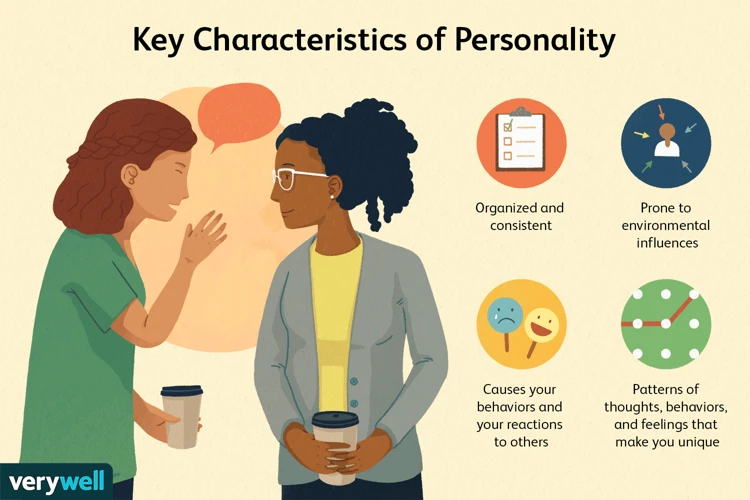
Personal associations and cultural influences play a significant role in understanding the symbolism of colors in dreams. While certain colors may have universal meanings, our personal experiences, memories, and cultural backgrounds can influence our interpretation of colors in dreams. Here are some examples to consider:
1. Personal Associations:
– For some, the color red may represent love, passion, and romance, while others may associate it with anger or danger.
– Blue might evoke feelings of calmness and tranquility for one person, while another may associate it with sadness or loneliness.
– The color yellow could symbolize happiness and joy for one individual, while someone else may associate it with caution or cowardice.
2. Cultural Influences:
– In some cultures, the color white represents purity, innocence, and celebration. In others, it may symbolize mourning or death.
– The color black can be associated with elegance and formality in some cultures, while in others, it may represent sadness or evil.
– Green, often associated with nature and growth, can hold different meanings in various cultures. It may symbolize fertility, luck, or even jealousy.
It’s important to recognize that personal interpretations and cultural influences shape our understanding of colors in dreams. By reflecting on our own experiences and considering the broader cultural context, we can gain a more nuanced understanding of the symbolism behind the colors that appear in our dreams. This allows us to interpret our dreams in a way that resonates with our unique perspectives and backgrounds.
Understanding Color Combinations

Understanding color combinations in dreams adds another layer of complexity to the symbolism present. When multiple colors appear together in a dream, they can interact and influence each other’s meanings, creating a unique blend of symbolism. The combination of colors in a dream can enhance, alter, or even contradict the individual meanings of each color. For example, the combination of red and blue may represent a merging of passion and calmness. It could indicate a state of conflict between intense emotions and a need for inner peace. Alternatively, the combination of yellow and green may signify personal growth and happiness. The vibrant energy of yellow harmonizing with the nurturing qualities of green could suggest a period of personal development and transformation.
It is also essential to consider the intensity or saturation of color combinations in dreams. Bright and vivid color combinations typically suggest heightened emotions or events, while muted or pale color combinations may indicate a more subdued or passive experience. For example, a dream filled with vibrant red and orange tones may signify a period of excitement, enthusiasm, or passion. In contrast, a dream with soft pastel colors like light blue and pink may indicate a sense of tranquility, harmony, or gentleness.
Not only do individual colors hold significance, but their combinations can offer a deeper understanding of the dream’s message. When interpreting color combinations, it is important to consider the context of the dream, the emotions felt, and any specific objects or symbols present. The symbolism of color combinations is highly subjective and can vary based on personal experiences and cultural influences. Taking all these aspects into account allows for a more comprehensive interpretation of the dream and the subtle nuances of its color combinations.
Interpreting the Intensity of Colors
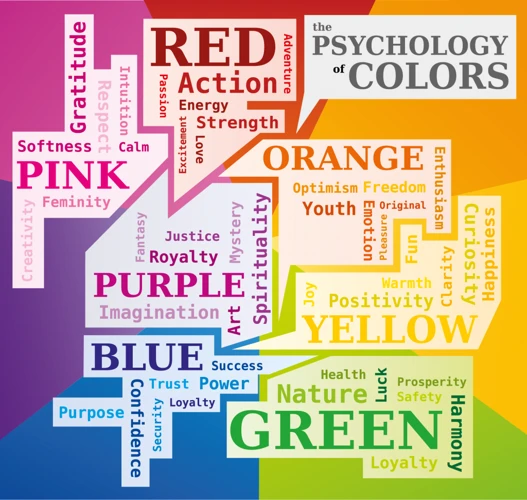
Interpreting the intensity of colors in dreams adds an additional layer of depth and meaning to their symbolism. The intensity of a color refers to its brightness, saturation, or vividness within a dream. Understanding the intensity can provide crucial insights into the emotions and energies associated with a particular color.
Bright and vibrant colors, such as bold reds or electric blues, often indicate intense emotions or strong energies at play in the dreamer’s subconscious. These colors may represent passion, excitement, or a heightened sense of awareness. For example, a vivid red color might suggest a surge of powerful emotions, such as anger, desire, or urgency. Similarly, a bright blue hue can symbolize a state of calmness, clarity, or deep spiritual connection.
On the other hand, muted or faded colors can indicate more subdued emotions, a sense of melancholy, or a lack of vitality. When colors appear washed out or dull in a dream, they may signify a decrease in energy or a need for rejuvenation. For instance, a pale yellow might suggest a decrease in optimism or a lack of vitality, while a faded green might represent a need for growth and renewal.
The intensity of colors can also change throughout the course of a dream, providing further insight into the dream narrative. For instance, a dream might start with vibrant and intense colors, indicating strong emotions or heightened awareness. However, as the dream progresses, the colors might gradually fade or become muted, representing a shift in emotions or a resolution of the initial intensity.
It is important to consider the context and personal associations with each color when interpreting their intensity in a dream. The intensity of colors can vary from person to person based on individual experiences, cultural influences, and personal preferences. It is crucial to reflect on one’s own emotions and associations with each color to gain a deeper understanding of the intensity portrayed in a dream. By paying attention to the intensity of colors in dreams, we can unlock additional layers of symbolism and gain deeper insights into our own emotions and subconscious desires.
Exploring Context and Situations
Exploring the context and situations in which colors appear in dreams is crucial for a comprehensive understanding of their symbolism. While individual color interpretations provide a foundation, it is important to consider the specific circumstances and surroundings in which these colors manifest within the dream. The context can greatly influence the meaning and significance of a particular color. For instance, the color red, typically associated with passion and energy, may take on a different connotation depending on the context. If red appears in a dream where the dreamer feels overwhelmed or threatened, it could indicate heightened emotions, stress, or even danger. On the other hand, if red appears during a joyful and celebratory dream, it may symbolize excitement, vitality, or success. Similarly, the color blue, often linked to calmness and tranquility, may have different interpretations based on the situation. If blue appears in a dream where the dreamer is feeling calm and at peace, it can reinforce a sense of emotional stability and contentment. However, if blue appears in the context of a dream involving isolation or sadness, it may represent feelings of loneliness or sadness. By analyzing the circumstances and situations surrounding the colors in dreams, we can unlock a deeper understanding of their symbolism and the messages our subconscious is trying to communicate. Such an analysis allows us to perceive the intricate and powerful connections between colors and our emotional states, leading to a more holistic interpretation of our dream experiences.
Conclusion
In conclusion, the symbolism of colors in dreams holds immense significance in unraveling the messages and meanings hidden within our subconscious minds. Colors have the power to evoke emotions, convey symbolism, and provide valuable insights into our thoughts, desires, and fears. Each color carries its own unique significance, representing a range of emotions and concepts. From red’s passionate intensity to blue’s calming serenity, and from yellow’s joyful optimism to black’s mysterious depths, every color in our dreams has meaning and purpose.
By paying attention to the colors that appear in our dreams, we can gain a deeper understanding of ourselves and the messages our subconscious is trying to communicate. Whether through the personal associations and cultural influences we have with certain colors or the interpretation of color combinations and intensity, exploring the symbolism of colors in dreams allows us to decode the stories our minds tell us while we sleep.
It is essential to approach color symbolism in dreams with an open mind and consider the context and situations in which the colors appear. Dream interpretation is a deeply personal process, influenced by our individual experiences, beliefs, and emotions. However, understanding the general interpretations of color symbolism can serve as a helpful guide in deciphering the messages within our dreams.
In conclusion, delving into the symbolism of colors in dreams can be a fascinating and enlightening journey. It invites us to explore the depths of our subconscious minds, unravel the hidden meanings behind our dreams, and gain deeper insights into our innermost thoughts and emotions. By embracing the vibrancy and intricacies of color symbolism in dreams, we can unlock the secrets they hold and embark on a path of self-discovery and self-reflection.
Frequently Asked Questions
1. What does it mean if I dream in black and white?
Dreaming in black and white may indicate a lack of clarity or a sense of ambiguity in your waking life. It could suggest a need to examine situations more closely or seek further understanding.
2. Why do certain colors repeat in my dreams?
Repetitive colors in dreams may signify recurring themes or emotions that your subconscious is trying to process. Pay attention to the specific colors and their associated symbolism to gain deeper insights into these patterns.
3. Can the interpretation of color symbolism in dreams vary across cultures?
Absolutely. Color symbolism can vary widely across different cultures and traditions. Cultural background and personal associations with colors can influence the interpretation of colors in dreams. It’s important to consider cultural context when analyzing color symbolism.
4. What does it mean if my dreams are filled with vibrant and intense colors?
Dreams filled with vibrant and intense colors often indicate heightened emotions or a strong energy surrounding the situations or emotions experienced in the dream. It may suggest a sense of passion, urgency, or significance in your waking life.
5. Are there any universal color symbols in dreams?
While colors can have universal associations, such as red symbolizing danger or green representing nature, it’s important to note that personal experiences and cultural influences play a significant role in the interpretation of color symbolism in dreams. The meaning can vary from person to person.
6. Can the same color have different interpretations in different dreams?
Absolutely. The same color can have different interpretations depending on the context and emotions associated with it in a particular dream. It’s essential to consider the specific circumstances and feelings surrounding the color to understand its intended meaning.
7. Can the color symbolism in dreams change over time?
Color symbolism in dreams can indeed evolve over time. As we grow, our perspectives and experiences shift, leading to changes in the meaning we associate with certain colors. It’s important to be open to the evolving nature of symbolism and remain receptive to new interpretations.
8. Are there any resources for further exploring color symbolism in dreams?
Absolutely. Books, online resources, and dream interpretation experts can provide valuable insights into color symbolism in dreams. It can be helpful to explore different perspectives and interpretations to gain a more comprehensive understanding.
9. Can the intensity of a color in a dream affect its interpretation?
Absolutely. The intensity of a color in a dream can enhance its impact and significance. Bright, vivid colors may represent heightened emotions or situations, while dull or faded colors could indicate a lack of vitality or emotional vibrancy.
10. How can I use the symbolism of colors in dreams to gain self-awareness?
By paying attention to the colors in your dreams and exploring their symbolism, you can gain deeper insights into your subconscious thoughts, emotions, and desires. Analyzing the colors can help you better understand yourself, your motivations, and your aspirations.

